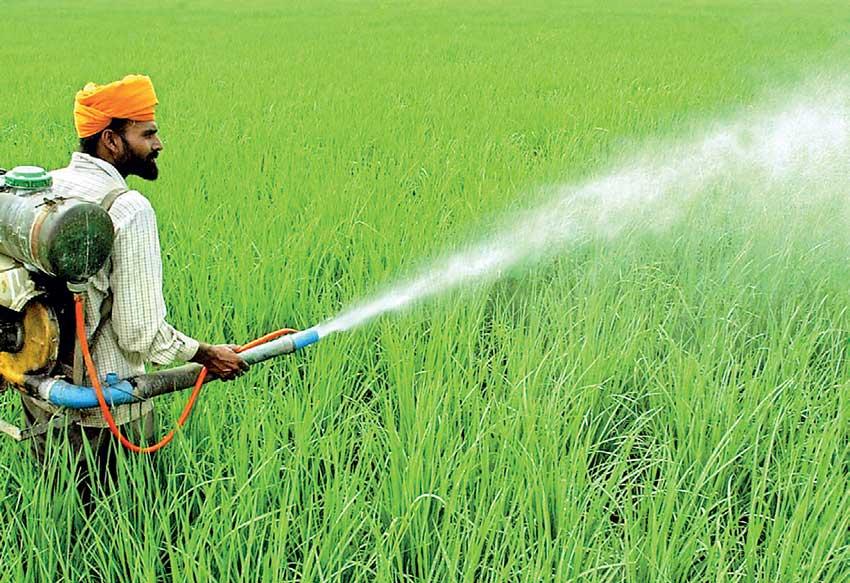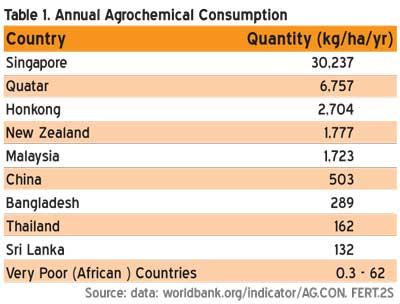Reply To:
Name - Reply Comment
Last Updated : 2024-04-24 10:25:00

 Some days ago, the media reported that the Agriculture and Mahaweli Development Minister addressing a farmers’ meeting in Embilipitiya had remarked that according to a World Health Organisation (WHO) report, Sri Lanka is the country consuming the highest amount of toxins (agrochemicals) in the world. As this is a statement that would shock the public, it is critically important that we examine the actual reported statistics.
Some days ago, the media reported that the Agriculture and Mahaweli Development Minister addressing a farmers’ meeting in Embilipitiya had remarked that according to a World Health Organisation (WHO) report, Sri Lanka is the country consuming the highest amount of toxins (agrochemicals) in the world. As this is a statement that would shock the public, it is critically important that we examine the actual reported statistics.
Of the total global croplands, only 2.1 percent is in organic farming, of which 66 percent is in pastures and the balance in arable and horticultural crops.
Given in Table 1 are published data from the World Bank on country-wise annual agrochemical use in several Southeast Asian and African countries.
Safe pesticide spraying
As per the Table 1 facts, it should be heartening for the public to learn that contrary to the fears expressed by anti-conventional agriculturists, Sri Lanka is among the lowest users of agrochemicals. As per the data, Singapore uses over 200 times agrochemicals as Sri Lanka and Malaysia, China and Bangladesh, 13, four and two times us, respectively.
That is not all, in 2015, the Pesticide Technical Evaluation Committee (PTEC), comprising the Agriculture Department and the other agricultural research institutes, made far-reaching revisions to reduce the very toxic pesticides then in use (Table2).
Thirty nine of the 40 highly toxic (Class 1) pesticides and 54 of the Class 2 toxic pesticides were disbanded concurrently, introducing a large number of less toxic Class 3 and 4
pesticides for use.
These being the facts, the utterance of the minister, who had been in the agriculture sector as deputy minister and later as minister for long years, is disappointing and will only mislead the farmers and public at large.
Transition from organic to conventional agriculture
Many, including some scientists, are of the view that we should revert from conventional or chemical farming to organic farming to reduce agro-toxins in the environment and food. This view is of people, who are not aware of realities.

Therefore, we should go back to the evolution of agriculture over the last 200 years to understand the facts of the matter. With the industrial revolution (1760-1840), the population and per capita income in Great Britain and Europe rose rapidly and with it, the demand for food. Hunger, looming large, drove many scientists into research towards development of new technologies for increasing food production.
In the first half of the 19th century (1820-1850), synthesis of ammonia (nitrogen) fertilizer and soluble phosphate was discovered. By then, the need for and sources of potash fertiliser had already been discovered. With these findings, synthesis chemical fertilizer became a reality.
In 1947, writing about British agriculture, famous British soil scientist Dr. John Russell said, “For us at the present time, it is hard to imagine how happy the farmers would have been to learn that a few bags of chemical fertilizers made in a factory could replace tonnes of farmyard manure.”
The question we should now ask is, if organic fertilizer could not meet the fertilizer demand for crops, then can it happen now?
One hundred years after the chemical fertilizer revolution came the Green Revolution, which comprised synthesis of high-yielding new grain varieties, which increased yields three to four times. Such high yields were possible only with increased chemical fertilizer and pesticide applications.
Nobel Laureate and Father of the Green Revolution, addressing the Nobel forum in 2000, stated that had the Green Revolution and agrochemical technologies did not develop, we would have had to use at least three times the land used in 1950 for crop production, implying the massive degradation of forests and environment.
Two studies have revealed, for example that to produce the global food requirement organically, 25-82 percent or 65-200 percent of excess land are required.
‘Yahapalana’ toxin-free agriculture project 
The above project commenced under the leadership of the former president, at SEMA (Strategic Enterprises Management Agency), bypassing the Agriculture Department and Ministry. A key advisor to the project was Ven. Ratana, who also manufactured an organic fertilizer concoction called ‘Pivituru Pohora’, which was sold to the Mahaweli farmers.
Some of us visited the area, where it was tested and met with the farmers. When questioned about the efficacy of the fertilizer, they looked at one another and remained non-committal. However, one farmer when questioned alone remarked that on application of Pivithuru Pohora, the paddy crop turned yellow and the farmers were compelled to surreptitiously apply urea.
When asked why they were so secretive about it, we were told that lorries of the daughter of a reputed politician from Polonnaruwa procured the produce as organically grown paddy at Rs.10 per kilogramme, above the standard price. However, the total project was a failure because of many reasons, including bad technology and mismanagement.
Organic farming or ‘toxin-free’ farming
As per the 2017 estimates, of the 1.5 billion hectares of the total global crop lands, only 32 million hectares or 1.5 percent of the total crop lands are in organic farming, of which 66 percent is in pasture and the balance in grain and horticultural crops.
Despite the overwhelming promotions, annually there is only one percent increase in organic farmlands. Although organic crops capture premium prices, expansion of organic agriculture is constrained by limitations in farmyard and other organic manures. There are numerous institutions attempting to generate microbial and other technologies to increase organic farming but hitherto suitable technologies have not evinced. Let us hope that it will happen.
Apart from organic farm produce gaining premium prices, addition of organic matter, whether in organic or conventional farms, enriches the soil and should be promoted.
Environmental pollution and misuse of agrochemicals
Conventional agriculture pollutes the environment and affects the health of living organisms. However, organic agriculture is not totally innocent in this regard. Production of greenhouse gases, a primary reason for global warming, is a result of, among other things, large heaps of farmyard manure and organic matter in organic farms.
Leaching of nutrients is reported to be higher from organic soils. According to a study conducted in Sweden in 1980, whereas 35 percent nitrogen leached from organic farms, the corresponding value was only 19 percent from conventional farms.
A major problem of pollution in conventional farming is excessive use of agrochemicals.
Apart from pollution, it is a waste of resources of both the farmer and government. If little is good, more should be better, is the view of farmers. An outstanding example is excessive use of phosphate fertilizer, especially in upland vegetable farms.
According to the research carried out by the Agriculture Department, in some 742 Nuwara Eliya farms, the phosphorus (P) level exceeded 60 parts per million) ppm, which is the environmental critical level for that nutrient, whereas in non-farm lands of the area, the P level is only 12 ppm.
For crop growth, the optimal requirement is only 30 ppm. Excess fertilizer use is evident from most vegetable growing farms. When exceeding the environmental critical level, the excess P leaches from the soils and is carried via the streams and rivers to the reservoirs below, especially in the dry zone, polluting the water. That causes algal blooms interfering with the water use and more importantly secreting toxins some of which are toxic to the liver and kidneys. In fact, they are suspected to be a cause for the kidney disease in Rajarata.
Misuse of pesticides is probably a more serious problem. A study conducted in Indonesia, Sweden and Canada many years ago established that 50-60 percent of the pesticide used can be cut down without loss of crop.
A serious problem with organic agriculture is mixing of chemical insecticides with organic ones. Some time ago, Prof. Nioki Motoyama of the University of Tokyo, showed that eight of the so-called organic pesticides in the market, contained abemectin and other highly toxic chemical pesticides.
Some of the products used in organic farming are as toxic as conventional agrochemicals. Sodium nitrate used in organic farming as a nitrogen fertilizer is mined in South America. It carries highly toxic sodium perchlorate as an impurity, which is known to enter the soil and water bodies. Then, sulphur, copper and copper sulphate are toxins for pests allowed for use in organic farmlands and the latter is a Class 1 toxin, which can bio-accumulate.
Further, rotenone and pyrethrum being natural pesticides are used in organic farming. However, rotenone is suspected to cause Parkinson’s disease and pyrethrum is carcinogenic. In short, natural pesticides can be as toxic as synthetic ones.
Further, as large amounts of farmyard manure and other organic material of the order of 20-30 tonnes/ha are added seasonally, much larger quantities of heavy metals such as cadmium, arsenic and lead can enter the soil than through chemical fertilizer.
For example, triple superphosphate (TSP) and air dried cow dung have 5.0 and 0.46 mg cadmium /kg. Accordingly, adding 30 tonnes/ha cow dung and 325 kg TSP will add to the soil 13.6 and 1.6 gm cadmium, respectively, highlighting the risk of accumulating heavy metals via organic fertilizers.
Given the facts of the matter, the minister’s prime duty is to ensure that farmers are properly educated on the judicious use of agrochemicals through a more effective technical and extension staff. At present, this is sadly lacking.
The new president’s agriculture policy statement states that while promoting organic agriculture in the entire country, the traditional agricultural villages will be encouraged to take up organic agriculture and two million home gardens will be converted to organic farms.
Promoting organic farming is to be appreciated as soils will be improved by replenishment of organic matter, critically important for tropical soils and at the same time, farmers would receive premium prices for their produce. However, whether these lofty targets are achievable, given the various constraints, especially the shortage of organic
fertilizers is the issue.

Add comment
Comments will be edited (grammar, spelling and slang) and authorized at the discretion of Daily Mirror online. The website also has the right not to publish selected comments.
Reply To:
Name - Reply Comment
US authorities are currently reviewing the manifest of every cargo aboard MV
On March 26, a couple arriving from Thailand was arrested with 88 live animal
According to villagers from Naula-Moragolla out of 105 families 80 can afford
Is the situation in Sri Lanka so grim that locals harbour hope that they coul